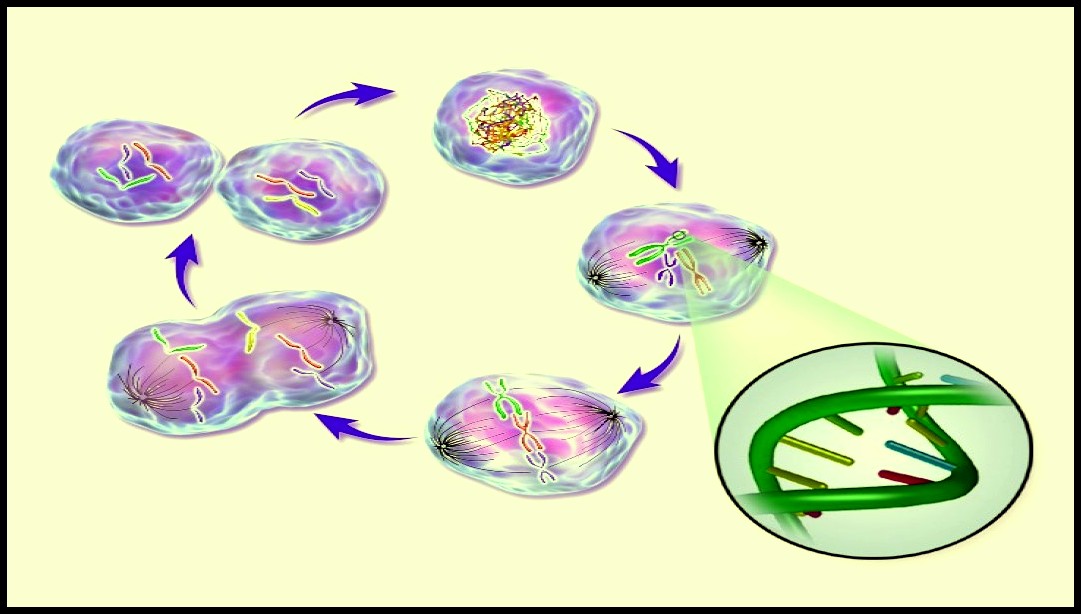Cell Cycle and Cell Division : Types of Division (Interphase)
Cell Cycle and Cell Division
Table of Contents
Cell Cycle
- Each new cell is formed by division of its parent cell.
- The series of changes that a cell undergoes from the time it forms until it divides is called the cell cycle.
- In other words, cell undergoing the process of Growth, development and reproduction is called cell cycle.
- For a cell to get divided, the cell must grow, synthesise materials like proteins, RNA, DNA etc. before splitting into two daughter cells.
- The duration of one cell cycle is known as Generation time.
- Hence, The cell cycle is a series of events that takes place in a cell leading to the duplication of its DNA and subsequent division of the cell to produce two daughter cells.
Phases of Cell Cycle
- The cell cycle has been divided into two phases –
- Non dividing phase called INTERPHASE
- Dividing phase called M-PHASE or mitosis
Interphase
-
- Non-dividing phase or preparatory phase.
- Lies between two successive cell division. The daughter cells produced from a mother cell are small, with less cytoplasm and full sized nucleus.
- During this phase, before entering the division , cell prepares itself for division by –
-
- Synthesis of Protein for cell division
- Replicating its DNA molecule
- Forming Daughter chromatids from DNA and histones
-
- Interphase is divided into 3 phases, namely –
-
- G1 phase – first Growth Phase
- S phase – Synthesis Phase
- G2 Phase – Second Growth Phase
-
Phases of Interphase
|
G1 phase First Growth Phase |
S phase Synthesis Phase |
G2 Phase Second Growth Phase |
§ Withdraw from cell cycle and enter Resting phase, or, § Start preparing for next division by entering Synthesis Phase. |
|
|
Cell Division
- Cell Division is a process by which parent cell divides into two identical daughter cells.
- The daughter cell has the exact copy of the hereditary materials their parent cells.
- The Cell division helps in growth, repair and reproduction.
Types of Cell Division
-
- The cell Division are of two types –
-
-
- Mitosis – cell division for growth and development. Leads to diploid cells.
- Meiosis – cell division leading to the production of Gametes. Leads to haploid cells
-
-
- Each cell division is divided into two phases –
-
-
- Karyokinesis – division of Nucleus
- Cytokinesis – division of the Cytoplasm
-
After the division of the cytoplasm, cell division is completed with the formation of two daughter cells.
Need of Division
-
- Growth – all multi cellular organism begins life with single cell. This single cell divides and replicates to produce the whole organism. This is due to the increase in number of cell.
- Repair – new cells are needed for healing wounds or to replace the damaged tissues etc.
- Replacement – our body constantly sheds cells which dies, to replace them cell division is required.
- Reproduction – essential for reproduction in living organisms.
Difference b/w Cell Cycle & Cell Division
|
Cell Cycle |
Cell Division |
|
It is the complete phases of the Cell life. |
It includes only division of cell. |
|
It includes Growth during Interphase, Karyokinesis and Cytokinesis. |
It includes only Karyokinesis and Cytokinesis. |
|
It is the series of periods of cell’s life. |
It is splitting of cell into two daughter cell. |
So, this was all about the Cell Cycle, Cell Division and types of Cell Division and Interphase.
In the Next Post (Click here), we will discuss about the Mitosis – Somatic cell division.



